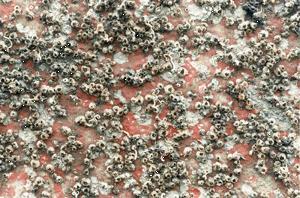
Barnacles and other marine organisms that attach themselves to ships can lead to a significant reduction the ship's speed and cause increased fuel consumption. Ships are therefore coated below the water line with special anti-fouling paint that prevents organisms from settling on the hull.
Sailing ships were traditionally coated with lime and later arsenic compounds. Today the shipping industry uses metallic compounds that are toxic to marine life. The compounds "leach" slowly into the sea water, killing barnacles and other marine life attached to the ship. They persist in the water and continue to kill sea life, harm the environment and may eventually enter the human food chain.
One of the most effective anti-fouling paints, organotin tributylin (TBT), was developed in the 1960s and was soon used by over 70% of the international fleet as well as on yachts. It has been shown to cause deformations in oysters and sex changes in whelks.
The International Maritime Organization (IMO) recognized the harmful environmental effects of organotin compounds in 1989. Three years later the Rio Conference on Environment and Development called for a reduction of pollution caused by organotins compounds used in anti-fouling systems. The International Convention on the Control of Harmful Anti-fouling Systems on Ships was adopted in 2001 and will come into force 12 months after 25 States representing 25% of the world's merchant shipping tonnage have ratified it.

Barnacles on a ship's hull.
Alternatives to TBT include copper based paints and silicone based paints that provide increased slippage and make it more difficult for organisms to attach themselves to the hull.
International Maritime Organization (2001 ) Anti-fouling systems. http://www.imo.org/ (accessed 13 October 2004).